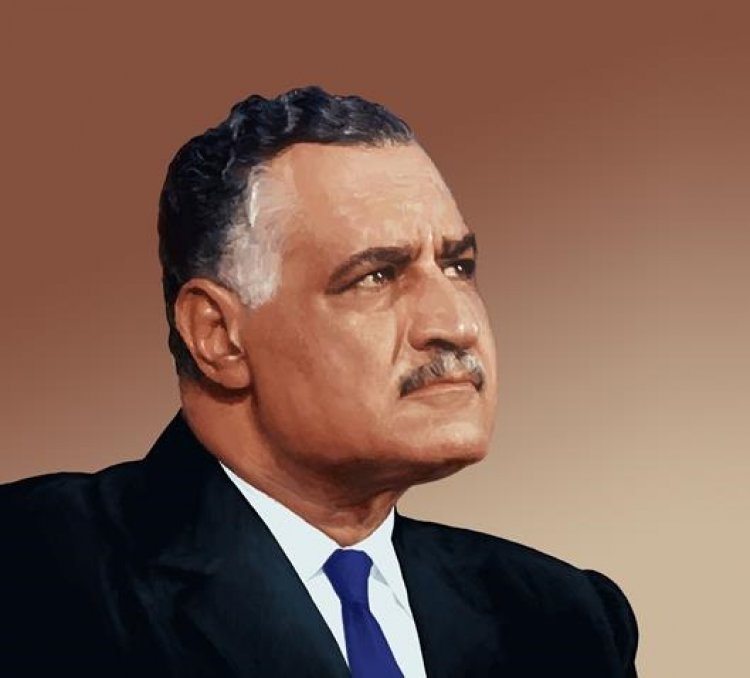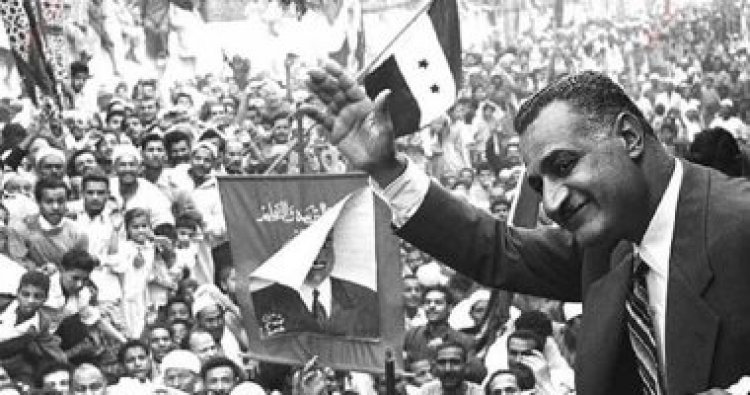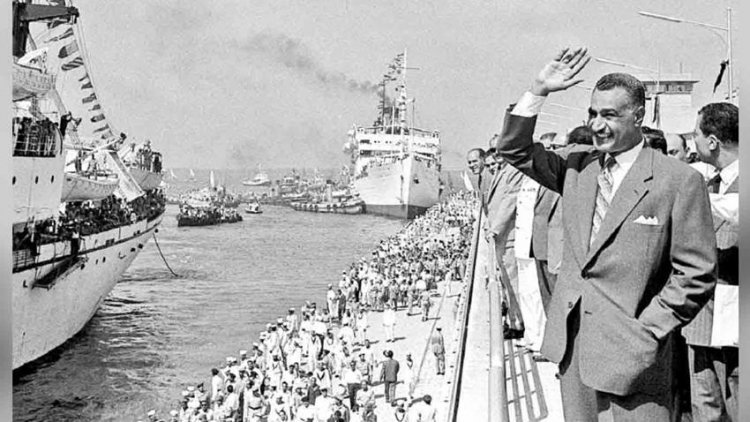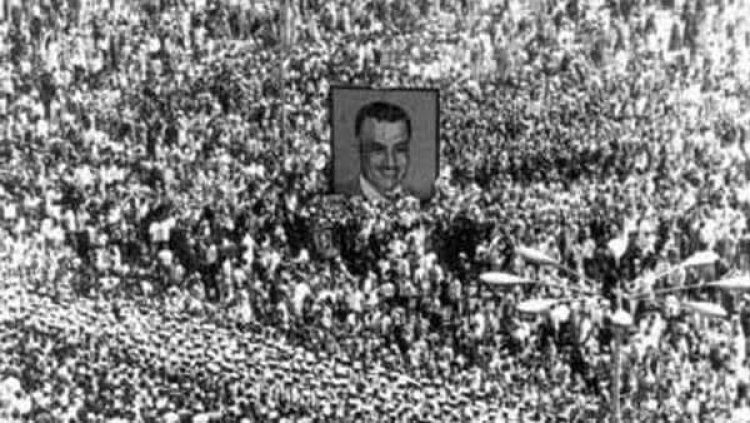Gamal Abdel Nasser
Prepared by: Dr. Hoda Gamal Abdel Nasser
Gamal Abdel Nasser was born on January 15, 1918 at 18 Qanawat Street in the popular Bakos district in Alexandria. Gamal Abdel Nasser was the eldest son of Abdel Nasser Hussein, who was born in 1888, in the village of Bani Mur in Upper Egypt, in his family of peasants. Yet, he obtained a degree of education that allowed him to join a job in the Postal Authority in Alexandria. His salary was hardly enough to pay the necessities of life.
Gamal Abdel Nasser joined the kindergarten in Muharram Bey in Alexandria. Then, in 1923 and 1924, he joined the elementary school in Al-Khattaba.
Nasser in elementary school
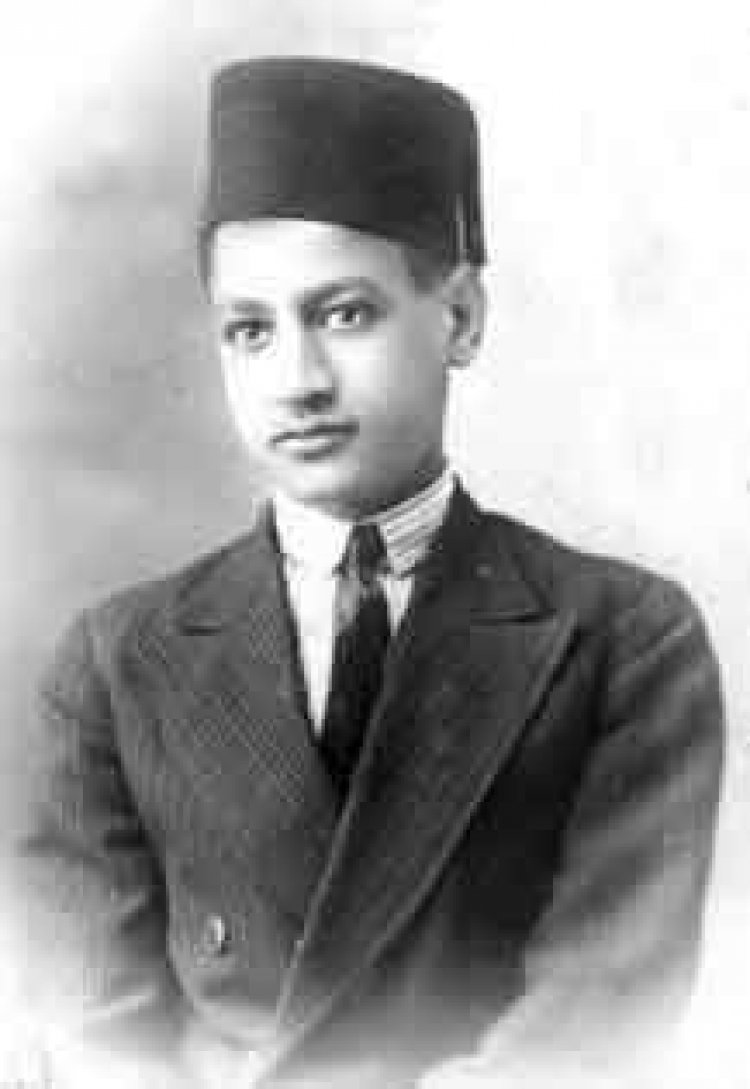
In 1925, Nasser entered Al-Nahhasin Primary School in Al-Gamaliya in Cairo. In a popular neighborhood, he lived with his uncle Khalil Hussein for three years and used to travel to visit his family in Al-Khattaba during school holidays. The following year (1926) when he arrived on summer vacation, he learned that his mother had died weeks before that and no one had the courage to inform him of her death. However, Nasser discovered it himself in a way that shook his being - as stated by David Morgan, the delegate of the Sunday Times. "The loss of my mother was in and of itself a very sad thing," he continued. "Losing her in this way was a shock that left me indelible by time. My own pains and sorrows during that period made me find a great reluctance to inflict pains and sorrows on others in the coming years."
In the summer of 1928, after Gamal completed the third year at Al-Nahhasin School in Cairo, his father sent himto his maternal grandfather. Thus, he spent the fourth year of primary school at Al-Attarin School in Alexandria.
Nasser in secondary school
In 1929, Gamal Abdel Nasser joined the boarding department at Helwan Secondary School and spent one year there. Then, in 1930 he was transferred to Ras El-Tin Secondary School in Alexandria after his father moved to work in a Postal Authority there.
In that school, Gamal Abdel Nasser's national conscience was formed. In 1930, Ismail Sidqi's ministry issued a royal decree to abolish the 1923 constitution. Student demonstrations erupted, yelling for the fall of colonialism and the return of the constitution.
"I was crossing Al-Manshiya Square in Alexandria when I found a clash between a demonstration of some students and police forces,"Nasser recounts the first demonstration in which he participated. "I did not hesitate to state my position. Without knowing anything about the reason they were demonstrating for, I immediately joined. It was unquestionable. I saw members of the masses clashing with the authority, as I took my stand without hesitation on the anti-authority side.
There were moments when the demonstration took control of the situation, but soon the supplies came to the place. Lorrain's load of policemen to strengthen the force, and their group attacked us. In a desperate attempt, they threw a stone, but they caught us in the blink of an eye, and I tried to escape.
Yet when I turned, I fell on my head with a stick of police, followed by a second blow when I fell. Then with blood flowing from my head, I was dragged to detention alongside number of students who could not escape fast enough.
When I was in the police station, and they began to treat my head wounds, I asked about the reason for the demonstration. I knew that it was a demonstration organized by the Young Egypt party at that time to protest against government policy.
I entered the prison as an enthusiastic student, and came out of it filled with an energy of anger.
On October 26, 1954, Nasser returned to this period of his life in Al- Khattabia in Al-Manshiya Square in Alexandria. He describes his feelings during that demonstration and the effects it left on him. "When I started to speak today in Al-Manshiya Square, I remembered the struggle of Alexandria when I was a young man," he said. "I remembered at this time that I participated with the Sons of Alexandria, and for the first time in my life I chanted in the name of freedom, in the name of dignity, and in the name of Egypt. Shots were fired at us from colonialism and the colonialists, so those who died died and others were wounded. But among these people came a young man who felt freedom and felt the taste of freedom, and it was his responsibility to strive and struggle and fight for the sake of freedom that he was chanting about and did not know its meaning. For he felt it in himself, and he felt it in his soul and he felt it in his blood.” That period in Alexandria was a stage of transformation in the life of the student Jamal. He went from a protester to a revolutionary affected by the boiling situation that Egypt was suffering from due to the rule of colonialism and the abolition of the constitution. School officials were fed up with his activity and alerted his father, so he sent him to Cairo.
In 1933, Gamal Abdel Nasser joined Al-Nahda Secondary School in Al-Zaher district in Cairo. He continued his political activity, becoming the head of the Al-Nahda Secondary Schools Union.
During that period, his passion for reading in history and national topics appeared. He read about the French Revolution, Rousseau and Voltaire, and wrote an article entitled Voltaire, the Man of Freedom, which he published in the school magazine. He also read about Napoleon, Alexander, Julius Caesar and Gandhi and read Les Miserables by Victor Hugo and a Tale of Two Cities by Charles Dickens.
He was also interested in Arab literary production. He was impressed by the poems of Ahmed Shawky and Hafez Ibrahim. He read about the biography of the Prophet Muhammad and about the heroes of Islam as well as about Mustafa Kamel. Moreover, read plays and novels by Tawfiq al-Hakim, especially the novel The Return of the Spirit, which talks about the necessity of the emergence of a leader for the Egyptians who can unite their ranks and push them towards the struggle for freedom and national revival.
In 1935, at the Al-Nahda High School ceremony, the student Gamal Abdel Nasser played the role of Julius Caesar, the hero of liberating the masses in the in Shakespeare's play. That was in the presence of the Minister of Education at that time.
The year 1935 witnessed a great activity for the Egyptian national movement, in which the students played the main role, demanding the return of the constitution and independence. A letter from Gamal Abdel Nasser to his friend Hassan Al-Nashar on September 4, 1935 revealed his inner self during this period. "We have moved from the light of hope to the darkness of despair. We have shaken off the omens of life and received the dust of death. So where is the one who will turn all this upside down, and return Egypt to its former condition when it was the owner of the world? Where is the one who creates a new successor so that the faint Egyptian voice becomes the weak hope that knocks? With their [Egyptians] head still, patient, in the upheaval of their right, forgetting about manipulating their country, attentive, loud, with great hope, raising their head, striving bravely and daringly to seek independence and freedom. Mustafa Kamel said, 'If I moved my heart from left to right, or moved the pyramids from its safe place, or changed the course of the Nile, I will not change the principle '. All of this is a long introduction to a longer and greater work, for we have talked several times about a work that awakens the nation from its slumber. A work that strikes the sensitive strings of the hearts and provokes what seems to be in the chests. But all of that has not come into action so far."
Two months later, as soon as Samuel Hoare, the British Foreign Secretary, issued a statement on November 9, 1935, declaring Britain’s rejection of the return to constitutional life in Egypt. As a result, student and worker demonstrations erupted in the country. On November 13, Gamal Abdel Nasser led a demonstration of secondary school students, which was confronted by a force of the English police. Nasser was wounded in the forehead by a bullet that tore the skin, but it did not penetrate the head. His colleagues rushed him to the house of Al-Jihad newspaper. As the accident happened next to the newspaper's headquarter, his name was published in the issue issued the next morning among the names of the injured. (Jihad Journal 1935).
Concerning the effects of the events of that period on the mental health state of Gamal Abdel Nasser, it was expressed by him in a speech at Cairo University on November 15, 1952. “My injury left a cherished mark that still remains on my face, reminding me every day of the patriotic duty placed upon me as a member of the sons of this dear country," he said." "On this day, the oppression and occupation fell upon the late Abdul Majeed Morsi, so I forgot what I am suffering from. It firmly established in myself that I have a duty to perish in its path or to be one of the workers in its fulfillment until it is fulfilled. This duty is the liberation of the homeland from colonialism, and the realization of the sovereignty of the people. As the martyrs fell dead, my faith in working to achieve Egypt's freedom increased."
Under popular pressure, especially from students and workers, a royal decree was issued on December 12, 1935 to restore the 1923 constitution.
At this time, Gamal Abdel Nasser joined the delegations of students who were seeking to the leaders' homes asking them to unite for Egypt. The National Front was actually formed in 1936 as a result of these efforts.
During this period of turmoil, Nasser wrote a letter to Hassan al-Nashhar on September 2, 1935, in which he said, " God Almighty says to prepare against them whatever you are able of power, so where is that strength with which we are preparing for them? The situation today is delicate and Egypt is in a more precise position.”
Gamal Abdel Nasser described his feelings in the book "The Philosophy of the Revolution". "In those days, I led a demonstration at the Al-Nahda School," he said. "And I cried from the depths of my heart asking for complete independence. And many shouted behind me, but our screams were in vain and the wind scattered it with weak echoes that neither move mountains nor break rocks."
However, the union of political leaders was a tragedy for the faith of Gamal Abdel Nasser. "Suez is protected from any aggression, and in the event of a war, the Egyptian lands, with its ports, airports, and means of transportation, will be at Britain’s disposal," he put it in the book The Philosophy of the Revolution. "The treaty also stipulated that the condominium would remain in Sudan."
As a result of Gamal Abdel Nasser’s intense political activity during this period, which was monitored by police reports, Al-Nahda School decided to expel him on charges of inciting students to revolution. Yet, his colleagues revolted and announced the general strike and threatened to burn the school down, so the school’s principal retracted his decision.
Since the first demonstration in which Gamal Abdel Nasser participated in Alexandria, he occupied politics all his time. He toured between the political currents that existed at this time. He joined the Young Egypt for two years, then left after discovering that it does not achieve anything. He had multiple contacts with the Muslim Brotherhood. However, he refrained from joining any of the existing groups or parties because he was not convinced of the feasibility of any of them, "there was no ideal party that included all the elements to achieve national goals."
Thus, when he was a high school student, Arab awareness began to creep into his mind. He went out with his colleagues every year on the 2nd of November to protest against the Balfour Declaration by which Britain granted the Jews a homeland in Palestine at the expense of their rightful owners.
Nasser as an officer
When Gamal Abdel Nasser completed his secondary education and obtained his baccalaureate in the literary stream, he decided to join the army. After the experience he went through in political work and his contacts with politicians and parties that disgusted him with them, he realized that the liberation of Egypt would not be accomplished through speeches. Rather that force must be met with force and the military occupation with a national army.
Gamal Abdel Nasser applied to the Military College and succeeded in the medical examination, but he failed in the commission’s examination. This is because he was the grandson of a farmer from Bani Murr and the son of a simple employee who owns nothing. Moreover, it was because he participated in the 1935 demonstrations, and because he had no intermediary.
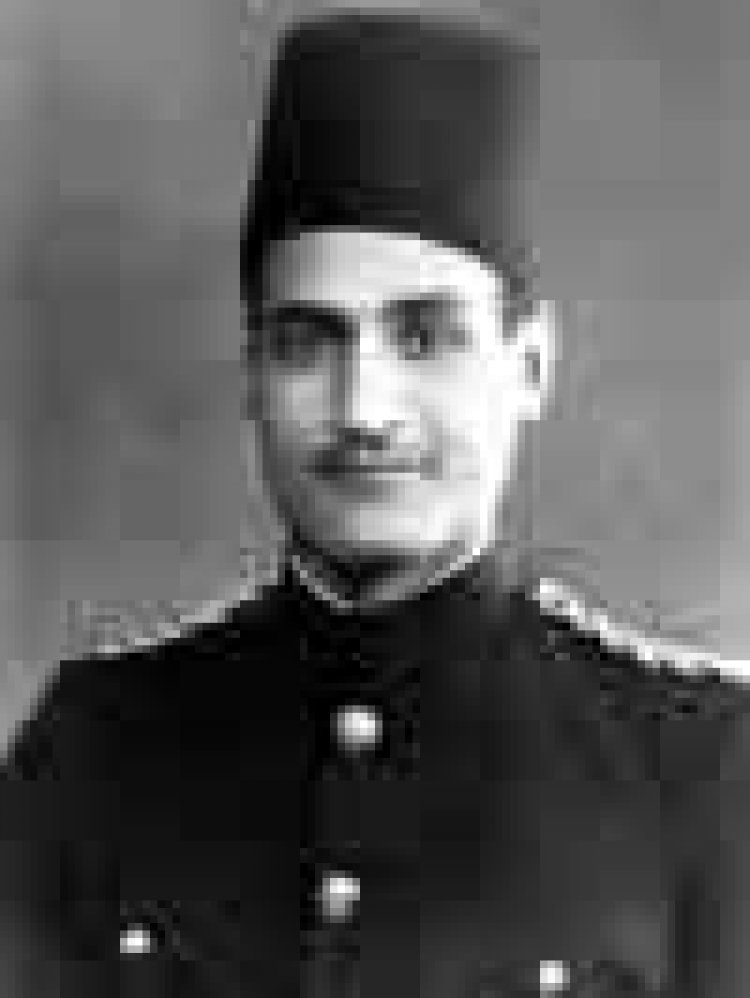
When the Military College refused to accept Gamal, he applied in October 1936 to the Faculty of Law at Cairo University. He stayed there for six months until the 1936 treaty was concluded. The intention was to increase the number of young Egyptian army officers, regardless of their social class or wealth. Thus, the Military College accepted a batch in the fall of 1936, as the Ministry of War announced that it needed a second batch. Nasser applied again to the Military College, but he reached the Undersecretary of the War Ministry, Major General Ibrahim Khairy, who was impressed by his frankness, patriotism, and insistence on becoming an officer. He agreed on Nasser's joining to the next course, that is, in March 1937.
Gamal Abdel Nasser set before him a clear goal at the Military College, which is "to become an adequate officer and to acquire the knowledge and qualities that allow him to become a leader." Indeed, he became a Lieutenant General. Since early 1938 he was assigned the task of qualifying new students, among whom was Abdel Hakim Amer. During the college period, Jamal did not receive any penalty, and was promoted to the rank of Umbashi Talib.
Gamal Abdel Nasser graduated from the Military College after 17 months, i.e. in July 1938. The graduation of officer batches at that time was rushed to provide a sufficient number of Egyptian officers to fill the void left by the British forces moving to the Suez Canal area.
Gamal Abdel Nasser graduated from the Military College after 17 months, i.e. in July 1938. The graduation of officer batches at that time was rushed to provide a sufficient number of Egyptian officers to fill the void left by the British forces moving to the Suez Canal area.
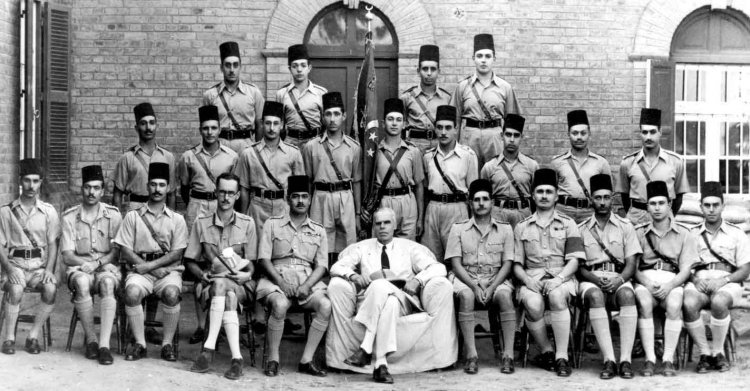
As soon as he graduated, Gamal Abdel Nasser joined the infantry and was transferred to Manqabad in Upper Egypt. In Manqabad, he met with Zakaria Mohieddin and Anwar Sadat.
In 1939, Gamal Abdel Nasser asked to be transferred to Sudan, where he served in Khartoum and in the Awliya Mountains. There he met Zakaria Mohy El-Din and Abdel Hakim Amer. In May 1940 he was promoted to the rank of first lieutenant.
The Egyptian army had until that time been a non-combatant army, and it was in the interest of the British to keep it in this state. However, the army began to enter a new class of officers who were looking to their future in the army as part of a larger jihad to liberate their people. Nasser went to Manqabad full of ideals, but he and his comrades were disappointed, as most of the officers were "incompetent and corrupt". Hence his thought turned to reforming the army and cleansing it of corruption. In 1941, he wrote to his friend Hassan al-Nashar from Jabal al-Awliya’ in Sudan: “In general, Hassan, I don't know were to start. All my faults are that I have been deceived."
"Someone with these qualities is respected by everyone but "the superiors". The presidents, O Hassan, are offended by the one who does not glorify their praise. They are mistreated by the one who does not flatter them. This is pride and they grew up in humiliation in the shadow of colonialism. They say, 'as they were treated, we too must be, and as they were seen we must be seen'. And woe, all woe to that who himself refuses to follow their path. It saddens me, Hassan, to say that this new generation has been corrupted by the old, sycophant. As for me, I have withstood with my principals, and that is why you find me in a persistent animosity with these 'superiors' ".
At the end of 1941, while "Rommel" was advancing towards the western Egyptian border, Gamal Abdel Nasser returned to Egypt and was transferred to a British battalion camped behind the battle lines near El Alamein.
"At this stage, the idea of revolution was completely firmly established in my mind, but the way to achieve it still needed study," Gamal Abdel Nasser recalls. "I was still feeling my way to that at that time, and most of my efforts at that time were directed to assembling a large number of officers. Most of my efforts at that time were directed to assembling a large number of young officers who I feel believe in their decisions in the interest of the country. By this alone, we would have been able to move around one axis, which is to serve this common cause."
While he was in El Alamein, the events of February 4, 1942 took place when the British ambassador Sir Miles Lampoon went to meet King Farouk in Abdeen Saray in Cairo after he surrounded the palace with British tanks. The formation of a cabinet cooperating with Britain and the king was handed over unconditionally.
Gamal Abdel Nasser mentions that since that date, nothing has been the same again. He wrote to his friend Hassan Al-Nashar on February 16, 1942 saying:
“I received your answer, and the truth is that what is in it made me more bitter and bitter. I was about to explode out of anger. But what to do after the incident occurred and we accepted it. The truth is that I think that the English were playing with one card in their hand for the purpose of threatening only, but if they felt that some Egyptians intended to sacrifice their blood and meet force with force, they would have withdrawn like any wretch."
As for the army, this incident had a new impact on the situation and the feeling in it. After you saw the officers talking only about women and amusement, they started talking about sacrifice and willingness to sacrifice souls for the sake of dignity.

You see them all regretting that they did not interfere - with their apparent weakness - and restore the country's dignity and wash it with blood. But tomorrow is near. After the accident, some tried to do something for the purpose of revenge, but it was too late, but the hearts are all fire and sorrow. In general, this movement or stab returned the soul to some bodies and taught them that there is a dignity that they must prepare to defend. And this was a lesson, but it was a harsh lesson.”
On 9 September 1942,Jamal Abdel Nasser was promoted to the rank of yuzbashi (captain) and on 7 February 1943 ,he was appointed as an instructor at the war college.In this period,a reading list was showed that he read for great military authors such as Liddell Hart and Clausewitz and he read political literatures and political books for Cromwell and Churchill.In this period,Jamal Abdel Nasser was preparing to join Staff School.On 29 June 1944,Jamal Abdel Nasser married Tahia Muhammad Kazem-the daughter of a merchant from nationals of Iran.He had known her family through his uncle Khalil Hussein.Gamal Abel Nasser had two daughters,Huda and Mona and three sons,Khaled,Abdul Hamid and Abdul Hakeem .Tahia played a important role in his life,especially in the stage of preparing for the revolution and Completing the Free Officers Organization Cells. When he was in the Palestine War,she afford his young family-Huda and Mona and helped him to hide weapons while he was training the white knights to work against British base in the Suez Canal in 1951 and 1952.
Free Officers Organization
1945 witnessed end of world war 2 and the beginning of the Free Officers Movements and Gamal Abel Nasser says in his interview with David Morgan, Gamal Abdel Nasser says,… until 1948,I focused on gathering people who were as distressed with the current situation in Egypt as I was,and who had enough courage and perseverance to make the necessary change and we were a small group of loyal friends that try to produce our deal with a common goal and a common plan.
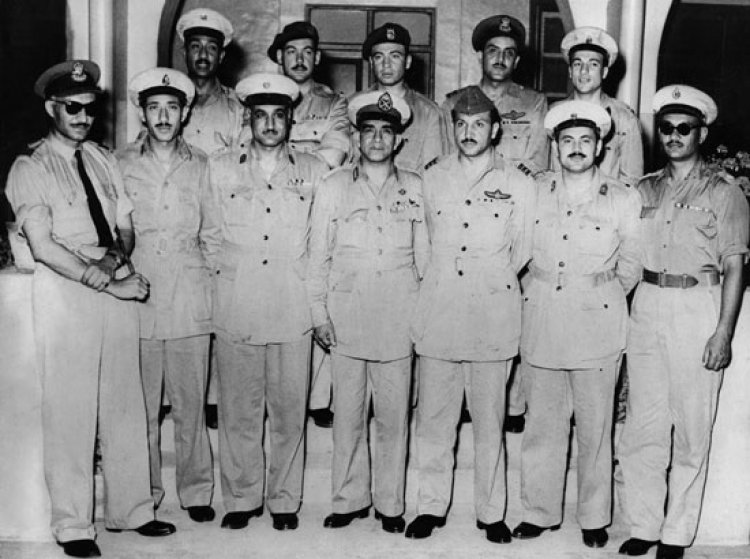
Following the issuance of the decision to partition Palestine in September 1947, the officers held a meeting and considered that the moment had come to defend Arab rights against this violation of human dignity and international justice and the stability of their opinion to help the resistance in Palestine.
In the next day,Jamal Abdulnasser went to The Mufti of Palestine who was a refugee residing in the new Egypt and he offered him his services and small group services as coaches of the volunteer squad and fighters and Mufti said that he could not accept the offer before accepting the Egyptian government after days,this offer was refused.He applied for holiday until he could join the volunteers, but before he could decide on his request, the Egyptian government officially ordered the army to take part in the war. Jamal traveled to Palestine on May 16, 1948, after he had been promoted to the rank of sagheer (major) in early 1948.
Palestine war affected on Jamal AbdulNasser where he said that there were not coordination among Arab armies and leadership workshop was non-existent.AS well as,our weapons were defective.In peak of the fighting were ordered for Corps of Engineers to build chalet for recreation Gaza of king farouk.Highest leadership focused on the widest possible area of land regardless of its strategic value or our general centre to fight the enemy or not and he was really resentful of the votelat officers or offices warriors who had no idea of the battlefields or the pain of combatant.The last drop came when I was instructed to lead a force from the Sixth Infantry Brigade to Iraq Suwaidan, which the Israelis were attacking, and before I began to move, our entire movements were published in the Cairo newspapers. Then came the siege of Al-Faluja, whose battles I lived through; Where the Egyptian forces continued to resist despite the fact that the Israeli forces were far superior to them in terms of numbers until the war ended with the armistice imposed by the United Nations” on February 24, 1949.
Gamal Abdel Nasser was wounded twice during the Palestine war and taken to hospital. Due to the distinguished role he played during the battle, he was awarded the “Military Star” Nishan in 1949.
After his return to Cairo, Gamal Abdel Nasser became confident that the real battle was in Egypt. While he and his comrades were fighting in Palestine, Egyptian politicians were accumulating money from the profits of corrupt weapons that they bought cheap and sold to the army.
He became convinced that it was necessary to focus efforts to strike Muhammad Ali’s family; King Farouk was the goal of organizing the Free Officers from the end of 1948 until 1952.
Jamal Abedel Nasser was planning to carry out the revolution in 1955, but unfortunately the events forced him to carry it out much earlier.
After returning from Palestine he has been appointed as a teacher at the staff college which he had passed with distinction on May 12,1948. The Free Officers reactivate, and an executive committee was formed; led by Jamal Abdel Nasser, included Kamal El-Din Hussein, Abdel Hakim Amer, Hussein Ibrahim, Salah Salem, Abdel Latif Al-Baghdadi, Khaled Mohi El-Din, Anwar El-Sadat, Hussein El-Shafei, Zakaria Mohy El-Din and Jamal Salem, a committee that became the Revolutionary Council a year later 1950, 1951.
On May 8,1951, Jamal Abdel Nasser promoted to the Bekbashi rank (Lieutenant Colonel), at the same year he participated in secret with his fellow Free Officers in the guerilla warfare against British forces in the Suez canal Zone, which continued until the beginning of 1952; by training volunteers and supplying weapons which was called for the armed struggle of youth of all political attituded which was out of the governmental framework.
At the beginning of 1952 and in view of Successive violent incidents; the Free Officers started to think of Political assassinations of the former regime’s poles as the only solution. And already they’ve started with Major general Hussein Serry Amer -One of the army commanders who was involved in the service of palace’s interests- but he survived death, this was the only assassination attempt in which Jamal Abdel Nasser has participated; everyone agreed to reverse this trend and divert efforts to positive revolutionary change.
With the beginning of the revolutionary mobilization phase; The Free Officers’ publications, which were printed and distributed secretly, were issued, which called for the army to be reorganized, armed and trained in earnest rather than limited to parties and parades, It also called the rulers to stop squandering the wealth of the country, raise the standard of living of poor classes, and criticized trafficking in ranks and medals, In that period, the corrupt weapons scandal had expanded along with economic scandals involving the delegation’s Government.
Then the Cairo fire occurred on 26 January 1952 after demonstrations broke out in Cairo to protest against the massacre of police officers in Ismailia by British military forces the previous day; in which 46 police officers were killed and 72 wounded, the fires started in Cairo, the authorities took no action, and the army ordered not to go to the capital until the afternoon, after four hundred buildings were destroyed by fire, leaving 12 thousand people homeless, with losses amounting to 22 million pounds.
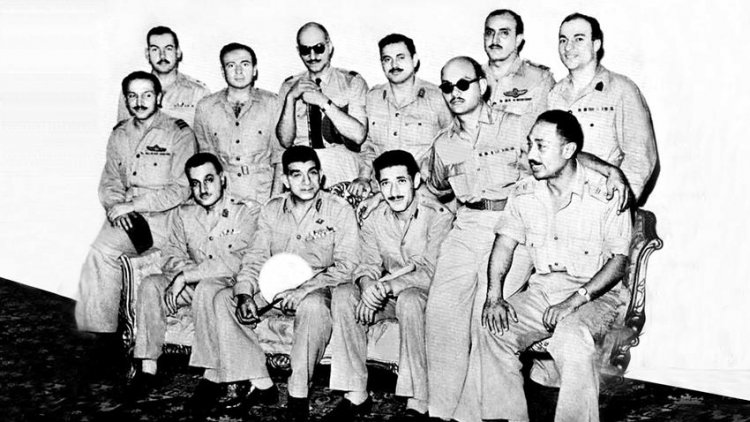
At that time, there was a blatant conflict between the Free Officers and king Farouq in what was known as the Army Officers’ Club elections crisis, King had nominated Major general Hussein Serry Amer “the hated army officers” to head the club’s executive committee, The Free Officers decided to submit their list of candidates; headed by Major General Mohammed Najib for the presidency, and despite the cancellation of the election on the instructions of the King in person, he was elected by a large majority, However, it was clear to the Free Officers that the army supported them against the King, and Jamal Abdel Nasser -head of the Foundation for Free Officers- had decided to bring forward the date of the revolution; which had been scheduled for 1955, In 23 July 1952 at night, the Army moved in and the Army Command Building was occupied at the qubba Bridge and the army commanders who were gathered to look for confrontation with the Free Officers’ movement were arrested after news leaked.
After the success of the army movement, Muhammad Najib was presented as the leader of the revolution – two months before, the Free Officers discussed him in the prospect of joining them if the attempt was successful – However, the effective authority was in the hands of the Revolutionary Command Council, which was headed by Jamal Abdel Nasser until 25 August 1952, when the Revolutionary Command Council decided to join Mohamed Najib as a member of the Council and assigned to him with its presidency after Jamal Abdel Nasser’s abdication.
Appointment of Jamal Abdel Nasser as a head of the Revolutionary Command Council.
Jamal Abdel Nasser designated as Chairman of Revolution Command Council.
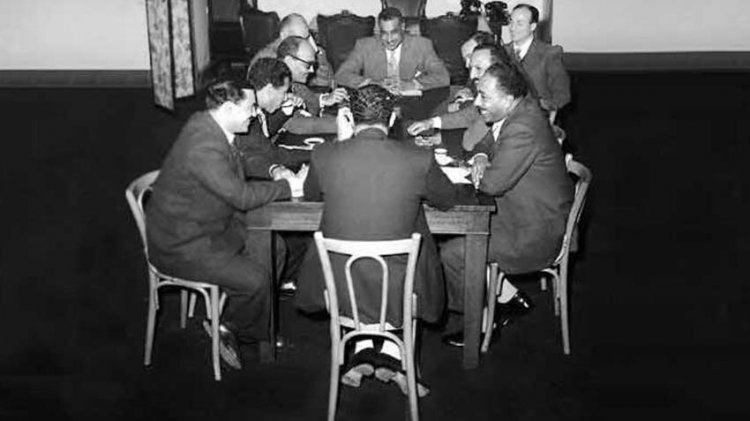
In response to Mohammed Najib’s resignation in February 1954 due to the growing disagreements with other members of the Revolution Command Council, Jamal Abdul- Nasser was designated Chairman of the Revolution Command Council and Prime Minister. On February 25, 1954, the council stated the following reasons for this disagreement:
“Citizens, the objective of the Revolution led by the army on July 23, 1952 was not for a person or persons to reach to a position or authority or to get money or jag. Indeed Allah attests that the Revolution was carried only to enhance the nation’s supreme Representation after having long lacked it due to the Covenants of the corruption and decay. The Revolution has faced severe challenges from the start, which have been resolutely overcome without regard to a person’s or group’s specific interest, strengthening its pillars and stepping up its progress towards its goals.
Without a doubt, you recognize the seriousness of the challenges created in the face of the Revolution, especially for the country in which a colonial usurper has occupied a portion of its territory. The mission of the RCC was extremely cruel and dangerous at that time. The members of the Council carried out that responsibility and pioneered the safety of our dear nation, no matter how much it cost them.
From the very beginning, the seriousness and gravity of the liability to the Council members was increased by the fact that they decided to present a leader of the revolution who was not a member of their own leadership Council, which was made up entirely of young men, at the time they were planning and preparing for the Revolution in secret. They select General Arkan Harb Mohammed Najib from among themselves to serve as the leader’s of the Revolution. He was not among their ranks, which is normal for the great discrepancy between his rank and theirs, as well as the age difference, whose pioneer behind this choice was his good reputation for not being contaminated by the corruption of that Covenant’s leaders.
Two months before, he was informed of that choice and was got approval for the revolution.
As soon as he was informed of the Revolution by a phone call from the then- minister of war, Mr. Mortada Al- Maraghi at his home. He immediately left his house went to the Revolutionary Council building to meet with its men as soon as they took over.
Since then, the situation has become more clear and the RCC’s work and discussions lasted for more than month without Major General Mohammed Najib’s participation, because until then, especially On August 25, 1952, he had not been included in the Revolutionary Council.
On that day, the Council decided to accept membership and assign him the presidency of the Council after it was waived by Al- Bakbashi, Gamal Abdel- Nasser, who was re-elected by the Council before the start of the Revolution as president for a year ending in October 1952.
Major General Mohammed Najib continued to suffer from a psychological crisis due to that peculiar attitude although we all displayed him to the world in the appearance of the President and leader of the Revolution and its Council while maintaining all of that leadership’s manifestations.
Less than six months, he began asking the Council to give him more power beyond the authority of the ordinary member of the Council. The Council has never accepted change its regulation, which was created many years before the Revolution, by requiring that all members, including the President, have equal power. The President will only be seated next to the teams in the Council if the votes are tied between the two teams.
Although his highness was appointed to be the President of the Republic while retaining the presidency of the Council of Ministers and the presidency of the Joint Conference, he was consistently insisting and requesting from time to time to have more powers than the Council . On the other side, our insistence was on total refusal to ensure maximum safeguards for the distribution of the State’s sovereign authority on the members of the Council.
Lastly, His highness, made specific requests:
He demanded to have the authority of veto-power on any decision of the members of the Council, knowing that the Council’s rules of procedure require any decision approved by a majority of the members.
He also requested that he began the authority to appoint and remove ministers, as well as the authority to approve the promotion and segregation of officers and even their movements, overall, he requested absolute individual authority.
In all possible ways we tried over the last ten months to convince him to go back his demands that made the country return back to autocracy, which cannot be accepted for our revolution. However, we were unable to persuade him completely.
After that, in order to force us to agree on his demands, his insistence occasionally continued which put us in front of a fait accompli three days ago. As he submitted his resignation despite the fact that he knew that any discord within the council in such circumstances it didn’t not secure its consequences.
Oh, citizens
Council members endured this constant pressure at a time that they were confronting tough problems facing the nations, which they inherited from old eras.
It all happens and the country is fighting with desperate struggles against a rapist in Egypt, Sudan and against a treacherous enemy strapped to its borders, also with a bitter economic battle, reforming the instrument of government and increasing production to the last those battles fought by the revolution.
Today, the revolutionary command council unanimously decided the following:
First: Acceptance of the resignation submitted by Major General Staff Muhammad Najib from all posts held by him.
Second: The Revolutionary Command Council, led by Al Bakbashi pillars of Jamal Abdel Nasser’s war, continues to take all its current authority until the revolution achieves its most important objective, with is the evacuation of the colonists from the homeland.
Third: Appointment of Al-Bakbashi Arkan Harb of Jamal Abdel-Nasser’s as Prime Minister.
We go back and think that this revolution will continue to be eager to its ideals, regardless of the obstacles and difficulties encountered, Excellent is the protector, and Excellent is the helper and Allah is the Arbiter of Success.
Soon, the manifestations of that disagreement were remedied, as the Revolutionary Command Council accepted Mohamed Najib’s return to the presidency of the Republic. That was in a statement issued on 27 February 1954.
Then, the riots orchestrated by the Muslim Brotherhood, which the Revolutionary Command Council issued a prior resolution to dissolve on 14 January 1954 (the Council’s resolution to dissolve the Muslim Brotherhood), began. Also some elements of the old regime involved in these incidents.
The conflict was manifested within the Revolutionary Command Council in this period; that was because of its resolutions rendered to draw back from the revolution. First, the three-year transitional period was abolished. Additionally, it was decided on 5 March 1954 to take immediate action in order to convene a Constituent Assembly, directly elected by universal suffrage, to meet in July 1954 in order to discuss and approve the new draft constitution, also to carry out the function of Parliament until such time as the new Parliament was convened in accordance with the Constitution to be approved by the Constituent Assembly .Simultaneously, it was decided to abolish martial law and censorship of the press and publishing.
Second, the Revolutionary Command Council decided to appoint Mohammed Najib as the Council’s President as well as Prime Minister after Jamal Abdel Nasser stepped down from the Head of Ministry and returned as Deputy Chairman of the Revolution Command Council.
Ultimately, on 25 March 1954, the Revolutionary Command Council decided to allow the institution of the parties and the dissolution of the Revolutionary Command Council on 24 July 1954, i.e. on the day of the election of the Constituent Assembly. (Council’s resolution to allow institution of political parties).
Although the Revolutionary Command Council cancelled those resolutions on 29 March 1954 (the Council’s decision to postpone the implementation of the resolutions of 25 March 1954), the crisis which took place in the Revolutionary Command Council created a division between Mohammed Najib, supported by Khaled Muhyiddin, and Jamal Abdel Nasser and the rest of the membership.
This conflict was reflected in the army, and politicians tried to exploit it, especially the Muslim Brotherhood and supporters of the old parties who were in Naguib’s side and in contact with him.
On 17 April 1954, Gamal Abdel Nasser assumed the presidency of the Council of Ministers and Muhammad Naguib confined himself to the presidency of the Republic until the Muslim Brotherhood tried to assassinate Gamal Abdel Nasser when a member of the group shot him as he spoke in Manshiyah Square in Alexandria on 26 October 1954, Investigations with the Muslim Brotherhood established that Mohammed Naguib was in contact with them and that he intended to support them if they succeeded in overthrowing the regime. On 14 November 1954, the Revolutionary Command Council decided to exempt Mohamed Naguib from all positions, The position of the President of the Republic remains vacant and the Revolutionary Command Council continues to assume all its powers under the leadership of Gamal Abdel Nasser.
On 24 June 1956, Gamal Abdel Nasser was elected President of the Republic by popular referendum in accordance with the Constitution of 16 January 1956 – the first Constitution of the revolution.
On February 22, 1958, Gamal Abdel Nasser became President of the United Arab Republic after maintaining unity between Egypt and Syria, This was until the secession plot by members of the Syrian army on 28 September 1961.
Gamal Abdel Nasser remained President of the United Arab Republic until his departure on 28 September 1970.
For more about President Gamal Abdel Nasser’s biography click here
Sources
Nasser Website


